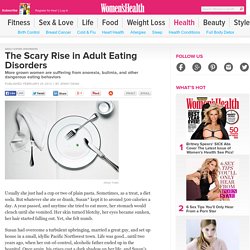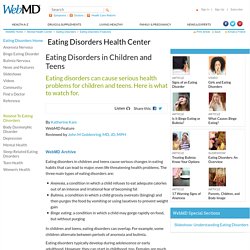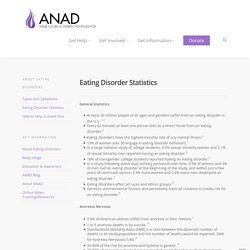

Question 6. Question 5. Question 4. Question 3. Question 2. Question 1. Types of Eating Disorders. Eating disorders.
Adult Eating Disorders: Anorexia, Bulimia, Compulsive Eating, and More. Kenji Toma Usually she just had a cup or two of plain pasta.

Sometimes, as a treat, a diet soda. But whatever she ate or drank, Susan* kept it to around 500 calories a day. A year passed, and anytime she tried to eat more, her stomach would clench until she vomited. Her skin turned blotchy, her eyes became sunken, her hair started falling out. Susan had overcome a turbulent upbringing, married a great guy, and set up house in a small, idyllic Pacific Northwest town.
By June 2011, the 5'4" Susan had lost over 40 pounds and weighed in at less than 100. Susan was 43. Eating disorders leaped into the national conscience in the 1970s and '80s, when the number of diagnosed cases exploded. Yet lately doctors have noticed a disturbing spike among a different group: women in their late twenties, thirties, and forties. Just like their younger counterparts, adult eating disorders deliver a mind-body punch that kills more people than any other mental illness. RELATED: The New Eating Disorders.
Eating Disorders in Children and Teens. Eating disorders can cause serious health problems for children and teens.

Here is what to watch for. Why do I need to register or sign in for WebMD to save? We will provide you with a dropdown of all your saved articles when you are registered and signed in. WebMD Archive Eating disorders in children and teens cause serious changes in eating habits that can lead to major, even life threatening health problems. Anorexia, a condition in which a child refuses to eat adequate calories out of an intense and irrational fear of becoming fat Bulimia, a condition in which a child grossly overeats (binging) and then purges the food by vomiting or using laxatives to prevent weight gain Binge eating, a condition in which a child may gorge rapidly on food, but without purging.
Eating Disorders Statistics - National Association of Anorexia Nervosa and Associated Disorders. General statistics: At least 30 million people of all ages and genders suffer from an eating disorder in the U.S.

Every 62 minutes at least one person dies as a direct result from an eating disorder.Eating disorders have the highest morality rate of any mental illness.13% of women over 50 engage in eating disorder behaviors.In a large national study of college students, 3.5% sexual minority women and 2.1% of sexual minority men reported having an eating disorder.16% of transgender college students reported having an eating disorder.In a study following active duty military personnel over time, 5.5% of women and 4% of men had an eating disorder at the beginning of the study, and within just a few years of continued service, 3.3% more women and 2.6% more men developed an eating disorder.Eating disorders affect all races and ethnic groups.Genetics, environmental factors, and personality traits all combine to create risk for an eating disorder.
Anorexia Nervosa: Bulimia Nervosa: “Diabulimia:” Eating disorders. Home > Body Image > Eating disorders About eating disorders "Mirror, Mirror on the wall...who's the thinnest one of all?

" According to the National Eating Disorders Association, the average American woman is 5 feet 4 inches tall and weighs 140 pounds. The average American model is 5 feet 11 inches tall and weighs 117 pounds. All too often, society associates being "thin", with "hard-working, beautiful, strong and self-disciplined. " Eating disorders are serious medical problems. Eating disorders are more than just a problem with food.
Although there is no single known cause of eating disorders, several things may contribute to the development of these disorders: Culture. Return to top Over-exercising Too much of a good thing can be very bad for you.